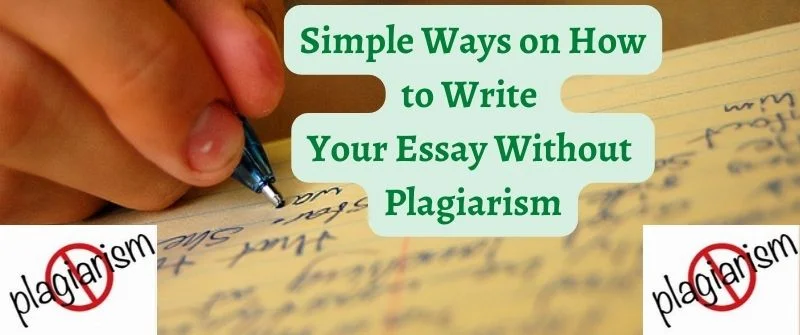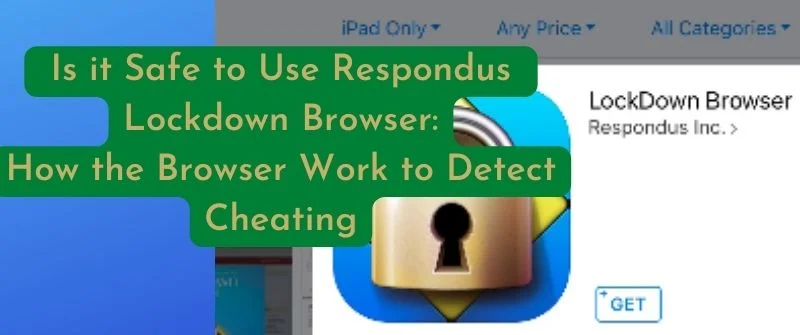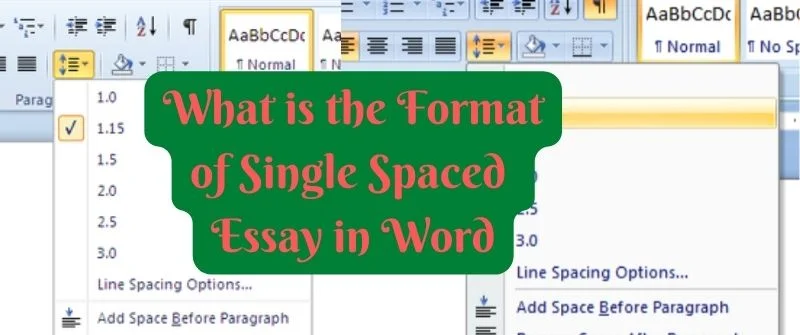Allowed Plagiarism Percentage for Academic papers and Blogs
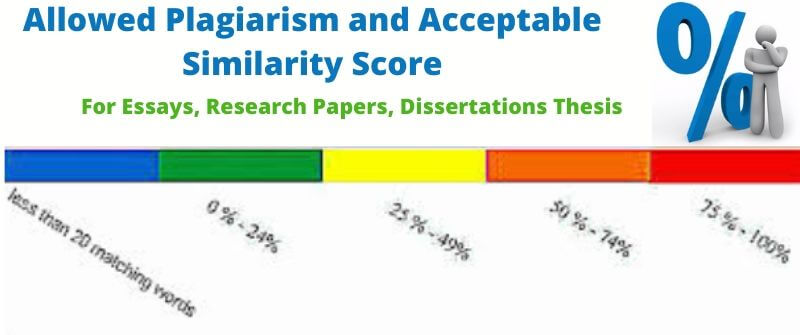
There are no universal rules set that determine the percentage of plagiarism that is allowed for essays, research papers, theses, or dissertations. Based on the feedback from our homework writing service, most students prefer plagiarism to be 0% or minimal.
The widely allowed plagiarism rate for academic papers, essays, and thesis is 25% and below for most universities and colleges. This rate works when the copied content for academic writing is well paraphrased and cited.
However, there is no universally acceptable plagiarism score since the allowed rate varies from one institution to another.
The issue of one rate being the allowed score, however, varies from one type of writing to another. While there is acceptable plagiarism in writing blogs and SEO, the case of allowed plagiarism is different in academic writing.
To allow a plagiarism percentage of 15, the matching text should not be on a continuous block. If so, the content is regarded as plagiarized work of significant concern.
The 15% plagiarism is accepted if the similarity is drawn from common terminologies and method-related details.
How much Plagiarism is Allowed in Academic Writing?
Different professions and disciplines allow different percentages of plagiarism. For example, journals allow up to 15% of plagiarism. Anything above that is considered highly plagiarized.
Most academic work, on the other hand, requires as minimal plagiarism as possible. However, students tend to plagiarize, especially those who submit late assignments and cheat.
Plagiarism Allowed for Research Papers
The largely allowed plagiarism for research papers is 25% and below. Any similarity score higher than that should be well-referenced and only relate to unavoidable phrases. However, there is no universally acceptable plagiarism rate. It all depends on what is plagiarized.
As a matter of advice, students should always keep in mind that the accepted plagiarism percentage for research papers is zero.
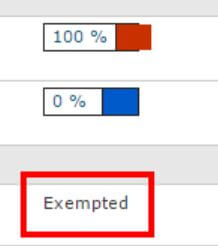
No student should think of using the work of another student or from other sources and present them as their own.
All this said it is always difficult to keep a plagiarism percentage of 0%.
Some unavoidable common phrases such as names of people, items on reference lists, titles, names on cover pages, names of institutions, and common section headers can amount to a certain amount of similarity when checked using online plagiarism-checking tools.
This leads to a need for instructors to go through the work. Different intuitions have established their acceptable levels of plagiarism in research papers.
Plagiarism Allowed for Essays
When it comes to essays, the commonly allowed plagiarism for essays is 25% and below. However, there is no determined plagiarism percentage that determines whether plagiarism is present in your work or not.
Essays are mostly checked for plagiarism using online plagiarism-checking software.
A high match of 20% sounds more than illegal, but it can be acceptable as long as the work is presented well and referenced appropriately.
On the other hand, a plagiarism match of 4% can be bad if the matched content is a continuous block of text from another source. It can also mean that there are insufficient sources to check the work with.
Plagiarism allowed for Thesis and Dissertations
As academic writing custom dictates, the allowed plagiarism for thesis and dissertations is 10-15 percentage is allowed in dissertations. In case of a higher score, it should relate to common phrases and terms that are well-referenced.
Any low plagiarism is acceptable, but the percentage allowed varies from institution to institution.
But the rule is that the only percentage of plagiarism that can be accepted everywhere is 0%. Even when the percentage of plagiarized work is low, it can be borrowed from a website or a popular source.
It is always important to cite and reference work properly before submitting them to instructors to avoid plagiarism.
Bear in mind that universities use plagiarism software to verify originality and deter cheating. In fact, a study done on plagiarism detection in universities showed that students actually reduced their plagiarism rates due to knowledge of plagiarism scanning.
Accepted Plagiarism for Published Journals line Elsevier
The level of plagiarism acceptable should be within 15%. This limit has been set this high to allow the natural requirements of citing references, quoting statements, and building content from previous research results.
This leads to the notion that when your paper has a plagiarism percentage of 25%, and there aren’t any cases of paragraphs copied, then your paper is fine.
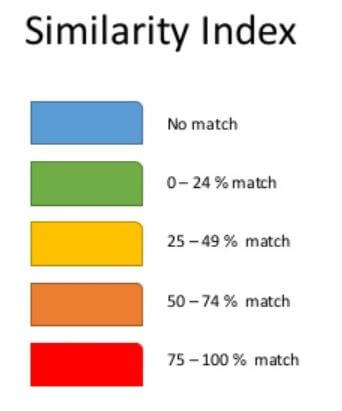
On the contrary, your paper can be of a percentage less than 10, but there is evidence of complete paragraphs that are ripped off from different sources.
This automatically makes your paper plagiarized.
A similarity that counts involves using quotation marks and citing methods and descriptions.
Authors can be allowed to re-use parts of their work only if the copyright holder permits them.
This can become easier if they retain the copyrights and use them transparently.
It is important to note that when close paraphrasing is done extensively, it can be regarded as plagiarism.
Anything apart from these should include content written in your own words. It is the only way you will prevent instructors from detecting plagiarism in your work.
How much Plagiarism is Allowed by Turnitin?
Turnitin checks similarity and provides similarity scores. When using Turnitin, instructors should determine whether plagiarism is present.
Turnitin flags all similar content, even if well-cited and quoted, raising the need for instructors to check all highlighted text. As a guideline, Turnitin regards a 15% score as safe and anything more than 25% as highly plagiarized work.
How much plagiarism is allowed by SafeAssign?
SafeAssign plagiarism scores only serve as a warning indicator. The papers need to be reviewed to prove if the flagged texts are plagiarized. SafeAssign scores usually have meaning.
- Scores between 0% and 15% represent papers that have included a few quotes and common phrases or texts that match other documents.
- Plagiarism scores between 15% and 40% represent papers with content that is extensively quoted and paraphrased.
- Any score over 40% represents papers that were copied from other sources excessively.
Types of Plagiarism Allowed in Academics
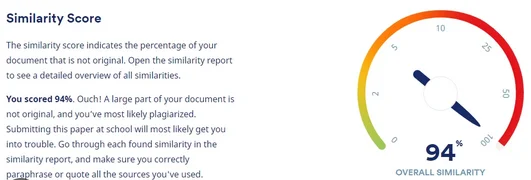
There is no type of plagiarism allowed. All writers should strive to ensure that any type of work they present is plagiarism-free.
There are types of plagiarism that are not as serious as others.
Accidental plagiarism
This is caused by unintentional paraphrasing and mistakes. For example, one may have reported a text properly but forgot to use quotation marks.
This type of plagiarism is common among students. Students should, therefore, be trained on how to avoid it.
Paraphrasing Plagiarism
It is also common among students. It involves making minor changes in sentences of someone’s work and using the work as your own. The idea remains the same even though words have changed.
It is, therefore, important to educate students properly on what constitutes plagiarism.
The Acceptable Plagiarism for Google and SEO Blogs
Allowed plagiarism for Google
When you post anything on your website, it is up to google to determine whether there is a similarity in the work compared to all other content on similar websites.
It is, therefore, important to always post plagiarism-free content on your website. Plagiarism on Google depends on content posted on other websites.
When your content is similar to the content of existing websites, you are likely to get fewer visitors on your website and rank lower on Google pages.
The consequences of plagiarism are severe on Google. Google can use context and differentiate content that is not stolen and content that is stolen. You risk your website being brought down by Google, among other disciplinary measures.
This is why you need to create unique, original, and authentic content for your website. Paraphrasing also doesn’t go well in Google’s view. Paraphrased worked work is not much different from the original work and, therefore, may lead to your work being termed as duplicate.
The most common one is writers paraphrasing content they have already posted on their websites. Writers should use plagiarism-checking software before they post content on websites.
Most of these tools check all available pages online. This should help you in producing original papers for your website.
Acceptable Plagiarism when Writing Blogs
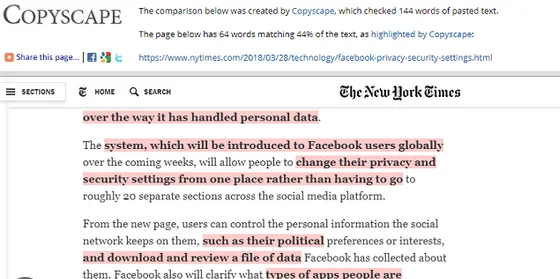
Though you can always strive to write original work, we live in a society where some people are more experienced and informed in specific areas. This is why you can quote someone just like someone else can quote your work.
In blogging, the allowed plagiarism for blogs is 30% and below. This is because such a rate is acceptable for similar content according to various checkers.
However, the way you present this borrowed content should be accurate. Attribute the writer and avoid passing the work as your own.
When you have instances of plagiarism after you check your work before submitting it, it is up to you to go through the work and determine whether the instances are acceptable.
Some bloggers don’t mind using plagiarized work. They will keep writing plagiarized work as long as it works. They are not worried as long as no penalties are being imposed.
Their work can have even 40% plagiarized work as long as they are not caught. If the search engine they are using decides to take down all content with 40% plagiarism text, they will quickly change their content to get a lower plagiarism percentage.
It is like an endless race that has no solution. Many may find this trick effective on a small scale, but in the real sense, they are fighting to survive rather than thrive.
Templates Cannot be Plagiarized in Blog Writing
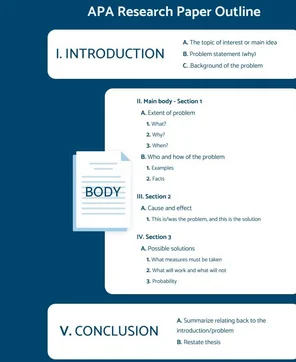
There has been a recent concern about whether templates can be plagiarized when writing blogs. Though they are very hard to detect if they have been copied from other websites, the layout used in a blog can be similar to the original.
This makes it plagiarized. However, some templates are well-attributed and licensed.
For example, WordPress themes can be used by everyone without any plagiarism concerns.
Many freelancers today have turned to using blogs to publish content and monetize their websites to make money.
Before writing a blog, you should strive to make everything original. Always make everything you write 100% unique.
Any result, even 2% of plagiarism, can bring you into trouble, especially if you copy something that is copyrighted or violates the ownership rights of other publishers.
Plagiarism in blogs occurs when the writer; fails to summarize or paraphrase other people’s work, fails to enclose direct ideas with quotes, and fails to cite the ideas and quotes of other authors.
Acceptable Plagiarism for SEO Writing
Not even 1% of plagiarism is allowed by SEO. The search engine data processing algorithms are very good when it comes to detecting plagiarized data. Plagiarism in SEO goes both ways.
The acceptable plagiarism for SEO writing is low scores not exceeding 15%, where such similarity cannot be avoided. Most search engines are not able to differentiate which work was copied from who. However, they penalize for similarity and this content. Therefore, never exceed 15% plagiarism for an SEO article.
This means that as much as you can damage your SEO efforts with plagiarism penalties, someone else can plagiarize your work, and you can be penalized for it as well.
Sometimes even your entire website can be stolen. To avoid such cases in SEO, you need to ensure your content is original by:
- Verifying and fact-checking sources of your content
- Making sure that every piece is written is fresh
- If you have writers, make sure that the guidelines you give them are clear.
- Hiring quality and experienced writers. Avoid cheap writers. Sometimes you get what you pay for.
There is always a need to monitor your work before posting it and after posting it to protect it as much as you can.
Tools you can use for these exercises include SEMrush Position Tracking, IFTTT, Copysentry, and Unplug.
You will also need to go through copyright rules and understand them fully. Know your rights, what is regarded as plagiarism, and what to do if your website is scrapped.


